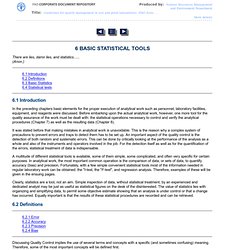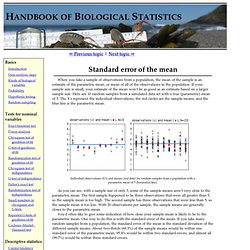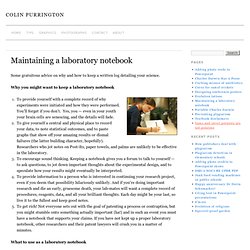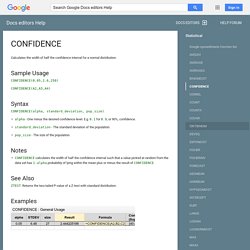

Select Content. 6 BASIC STATISTICAL TOOLS. There are lies, damn lies, and statistics......

(Anon.) 6.1 Introduction 6.2 Definitions 6.3 Basic Statistics 6.4 Statistical tests 6.1 Introduction In the preceding chapters basic elements for the proper execution of analytical work such as personnel, laboratory facilities, equipment, and reagents were discussed. Before embarking upon the actual analytical work, however, one more tool for the quality assurance of the work must be dealt with: the statistical operations necessary to control and verify the analytical procedures (Chapter 7) as well as the resulting data (Chapter 8). It was stated before that making mistakes in analytical work is unavoidable. A multitude of different statistical tools is available, some of them simple, some complicated, and often very specific for certain purposes.
Clearly, statistics are a tool, not an aim. 6.2 Definitions 6.2.1 Error 6.2.2 Accuracy 6.2.3 Precision 6.2.4 Bias. Standard error of the mean. When you take a sample of observations from a population, the mean of the sample is an estimate of the parametric mean, or mean of all of the observations in the population.

If your sample size is small, your estimate of the mean won't be as good as an estimate based on a larger sample size. Here are 10 random samples from a simulated data set with a true (parametric) mean of 5. The X's represent the individual observations, the red circles are the sample means, and the blue line is the parametric mean. As you can see, with a sample size of only 3, some of the sample means aren't very close to the parametric mean. The first sample happened to be three observations that were all greater than 5, so the sample mean is too high. You'd often like to give some indication of how close your sample mean is likely to be to the parametric mean. Here's a figure illustrating this. Usually you won't have multiple samples to use in making multiple estimates of the mean.
Similar statistics Example. How to Write A Paper in Scientific Journal Style and Format: Table of Contents - Bates College. Maintaining a laboratory notebook » Colin Purrington. Some gratuitous advice on why and how to keep a written log detailing your science.

Why you might want to keep a laboratory notebook To provide yourself with a complete record of why experiments were initiated and how they were performed. You’ll forget if you don’t. Yes, you — even in your youth your brain cells are senescing, and the details will fade.To give yourself a central and physical place to record your data, to note statistical outcomes, and to paste graphs that show off your amazing results or dismal failures (the latter building character, hopefully).
Researchers who jot notes on Post-Its, paper towels, and palms are unlikely to be effective in the laboratory.To encourage sound thinking. What to use as a laboratory notebook Purchase a notebook that possesses a stitched binding. What to put on the outside of your notebook Put your full name and year of use on the front of notebook.
Tips on how to keep your notebook What to write with Here are some conclusions: Using this page. Hillis, Principles of Life, 1E BCS. CONFIDENCE - Docs editors Help. Calculates the width of half the confidence interval for a normal distribution.

Sample Usage Syntax CONFIDENCE(alpha, standard_deviation, pop_size) alpha - One minus the desired confidence level. E.g. 0.1 for 0.9, or 90%, confidence.standard_deviation - The standard deviation of the population.pop_size - The size of the population. Notes CONFIDENCE calculates the width of half the confidence interval such that a value picked at random from the data set has 1-alpha probability of lying within the mean plus or minus the result of CONFIDENCE. See Also ZTEST: Returns the two-tailed P-value of a Z-test with standard distribution.
Examples Share this: Mary is a Docs & Drive expert and author of this help page. Was this article helpful?